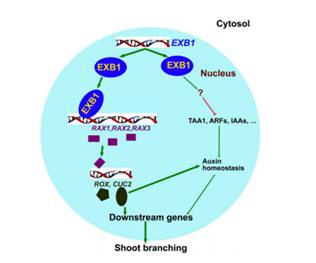Peking University, Dec. 8, 2015: When you are sitting in the shade of those towering trees, do you ever think about how they extend their long, luxuriant branches? How those little buds develop into boughs and twigs?For decades scientists have been working on this problem and successfully identified several important genes (such as RAX1, RAX2, RAX3) that regulate plant shoot branching. However, the most part of this mechanism remains unknown.
Professor Qin Genji of the School of Life Sciences and his team recently reported a novel gene that decides branching or not, telling us more about this long-standing puzzle. Their exciting findings were published in The Plant Cell, a prestigious international journal.
The pinpointed new gene is called EXB1(EXCESSIVE BRANCHES1). In their experiment, the researchers introduce an activating EXB1 into Arabidopsis. The resultant plant (designated exb1-D) exhibits excessive branches. What is more, when researchers disrupt EXB1, the resultant plant shows defeats of shoot branching. Both experiments confirm the pivotal role of EXB1.

Figure 1 A) Wild-type Arabidopsis and exb1-D mutant; B) Exb1-D ArabidopsisFrom Qin Genji et al.; “The WRKY Transcription Factor WRKY71/EXB1 Controls Shoot Branchingby Transcriptionally Regulating RAX Genes in Arabidopsis”, Plant Cell. 2015 Nov 17.pii: tpc.15.00829.
The scientists further explore the working mechanism of EXB1. They downregulate RAX genes in the EXB1 overexpression mutant, this returns the excessive branching plant to a less branching one. The result suggests that EXB1 might probably work through regulating RAX genes. Previously, RAX genes (RAX1, RAX2, and RAX3) had been proved to control shoot branching.

Figure 2 Working Model for EXB1.
From Qin Genji et al.; “The WRKY Transcription Factor WRKY71/EXB1 Controls Shoot Branchingby Transcriptionally Regulating RAX Genes in Arabidopsis”, Plant Cell. 2015 Nov 17.pii: tpc.15.00829.
Their work might provide insight into plant architecture, which is important for plant breeding and food production. Although there is a long way before we can fully elucidate how plant branches, we are looking forward to more findings in the future.
This work was supported by the National NaturalScience Foundation of China (Grant 31270321), by the National TransformationScience and Technology Program (Grant 2014ZX08009003-003), and by the National Key Basic Research Program of People’sRepublic of China (Grant 973-2012CB944801).
For the original Plant Cell paper, please click:

